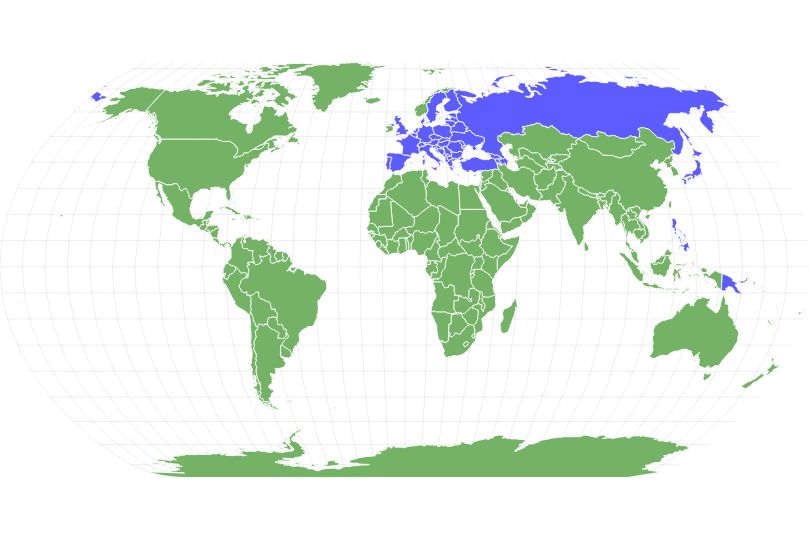Honey Buzzard
Honey buzzards are medium-sized raptors that earned their names by raiding the nests of bees and wasps.
Advertisement
Honey Buzzard Scientific Classification
Read our Complete Guide to Classification of Animals.
Honey Buzzard Conservation Status
Honey Buzzard Facts
- Prey
- Wasp and bee larvae, young birds, and frogs.
- Fun Fact
- Honey buzzards are medium-sized raptors that earned their names by raiding the nests of bees and wasps.
- Biggest Threat
- Larger raptors, habitat loss, and reduced availability of prey
- Wingspan
- 4.2 to 4.9 feet
View all of the Honey Buzzard images!
Honey buzzards are medium-sized raptors that earned their names by raiding the nests of bees and wasps.
But their name is actually a misnomer since it’s the insects themselves, not honey, that make up the bulk of their diet. There are six species of honey buzzards, which are distributed across the globe. Remarkably, four of these species aren’t buzzards at all, they’re kites! Plus, honey buzzards are sexually dimorphic, which means that males and females look different, which is rare for birds of prey.

Habitat
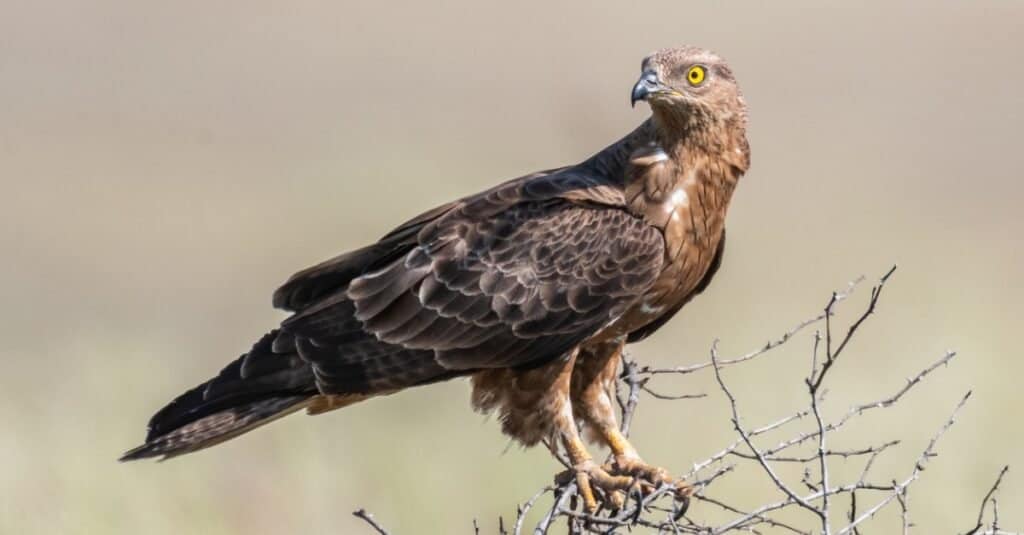
Honey Buzzards can be found in Europe, Asia, and Oceania. The European subspecies winters in Africa
©iStock.com/MriyaWildlife
Other honey buzzard species can be found in:
- Japan
- The Philippines
- New Guinea and the western Papuan islands
- Other southeast Asian countries
Scientific Name

Honey buzzards share the same ancestors as eagles, hawks, harriers, and kites, and are related to them, as result
©John Navajo/Shutterstock.com
These buzzards belong to the family of Accipitridae. This family includes around 250 species of raptors, including buzzards, eagles, hawks, kites, and Old World vultures. Birds from this family can be found on every continent in the world except for Antarctica. Moreover, birds of prey have adapted to a wide variety of habitats, including deserts, grasslands, forests, and marshes.
Birds in the Accipitridae family eat a wide range of food, including other birds, carrion, small mammals, and even fruit. They crush and puncture their prey with their sharp talons and easily rip skin and flesh with their hooked bills.
There are six species of these buzzards, some of which have subspecies as well.
Evolution and Classification
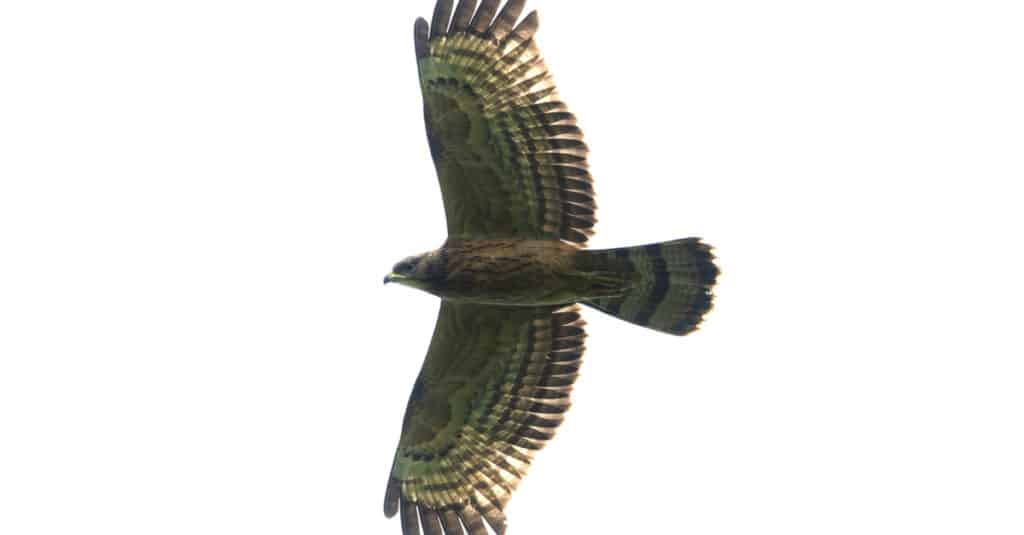
Honey Buzzards are related to several bird species including eagles, hawks, harriers, and even vultures
©Independent birds/Shutterstock.com
As part of the genus Pernis, honey buzzards also belong to the subfamily Perninae. As a result they are related to kites which are members of three genera in this larger group: Chondrohierax, Elanoides, and Leptodon. They are also related to the Philippine eagle which belongs to the genus Pithecophaga, under this same biological umbrella.
Every member of Perninae belongs to the Family Accipitridae. As a result, honey buzzards are also related to eagles, harriers, hawks, and even vultures.
Scientists possess excellent fossil evidence of the ancestors of these birds dating as far back as the late Eocene about 35 million years ago. Experts assert that the modern birds existed from about 30 million years ago although their ancestors first came on the evolutionary scene about 50 million years ago.
Types of Honey Buzzards
- Black Honey Buzzard (Henicopernis infuscatus) ― The black honey buzzard dwells on steep slopes and in mountain forests in Papua New Guinea. This raptor is usually solitary or paired and is frequently seen soaring over forest ridges.
- Long-Tailed Honey Buzzard (Henicopernis longicauda) ― The long-tailed honey buzzard can be found in New Guinea and some of its surrounding islands. These large, long-tailed birds of prey are often spotted soaring above the canopy of lowland and mountain forests and clearings.
- European Honey Buzzard (Pernis apivorus) ― Like other birds in the genus Pernis, the European honey buzzard is actually a kite, not a buzzard. Its legs and feet are armored with heavy, protective scales that defend the bird from insect stings. The European Honey Buzzard is also known as the Western honey buzzard or a pern.
- Barred Honey Buzzard (Pernis celebensis) ― The barred honey buzzard, also known as the Sulawesi honey buzzard, can be found in Indonesia and the Philippines. These birds of prey dwell in tropical or subtropical moist lowland or mountain forests.
- Philippine Honey Buzzard (Pernis steerei)― Also known as the Steere’s honey buzzard, the Philippine honey buzzard has short, dense, overlapping feathers on its lores (the area between its eyes and the upper base of its beak). These specially adapted feathers protect the bird from being stung when it raids bee and wasp nests.
- Oriental Honey Buzzard (Pernis ptilorhyncus) ― The oriental honey buzzard is larger than the European buzzard, and it has longer wings. It migrates in large flocks numbering in the thousands.
Size, Appearance and Behavior

©iStock.com/MriyaWildlife
These buzzards are medium-sized raptors. Their size and weight vary from species to species. The European buzzard weighs between one and two pounds and has a wingspan of 4.2 to 4.9 feet. Females of all six species are generally larger than males. All of these birds are sexually dimorphic, which means that the males and females can be differentiated by their coloring, feather patterns, and other physical characteristics. This trait is highly unusual among birds of prey.
All six types of these birds have physical adaptations that protect them from being stung as they capture and kill their prey. These adaptations include heavy, armor-like scales on their feet and legs and dense, overlapping feathers on their lores. They are able to capture their prey efficiently thanks to their long, curved bills, which have elongated tips designed to hold insects securely. And their narrow nostrils prevent their noses from becoming clogged with wax or soil from their prey’s nests.
These buzzards are difficult to identify because they closely resemble the common buzzard. Experts believe that this is a defense against the Goshawk, which could easily defeat this bird because the latter’s beak is designed to kill grubs, not larger, stronger prey. Common buzzards, on the other hand, have much stronger beaks, which usually dissuade goshawks from attacking. Asian honey buzzard species have plumage that resembles local hawk-eagles for the same reason.
Diet
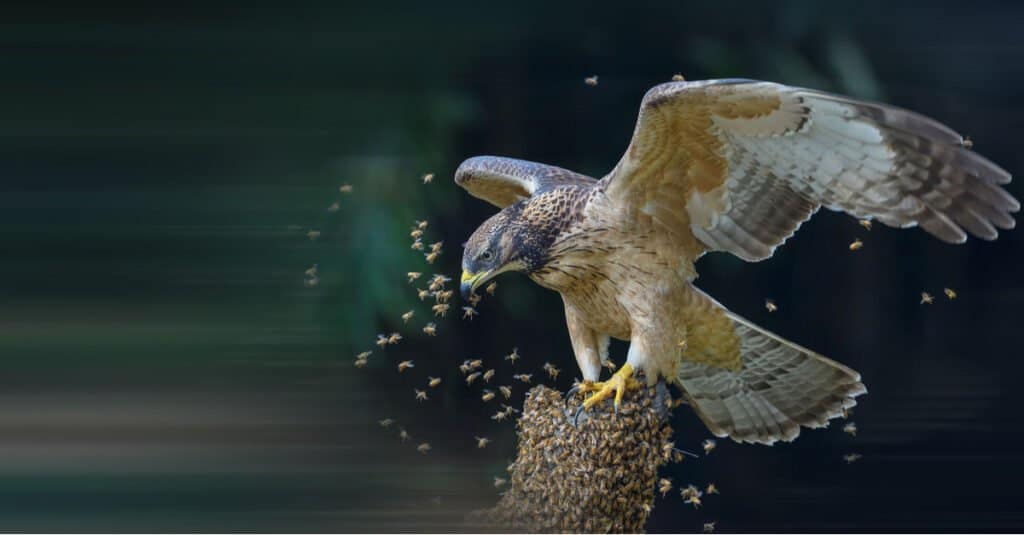
Honey Buzzards are especially fond of bee and wasp larvae
©Wang LiQiang/Shutterstock.com
The name “honey buzzard” is a misnomer. They undoubtedly ingest some honey when they raid a bee’s nest, but consuming the sweet substance isn’t their objective. Unlike other birds of prey, honey buzzards are primarily insectivores. Though their staple foods are wasp and bee larvae, they also consume young birds and frogs. They even eat fruit on occasion.
Predators and Threats
Larger raptors, habitat loss, and reduced availability of prey are the biggest threats to honey buzzards. European honey buzzards are vulnerable to hunters during migration. Also, in seasons when wasps aren’t abundantly available, European honey buzzards experience higher chick mortality and are likely to abandon chicks that haven’t developed properly.
What Eats the Honey Buzzard?
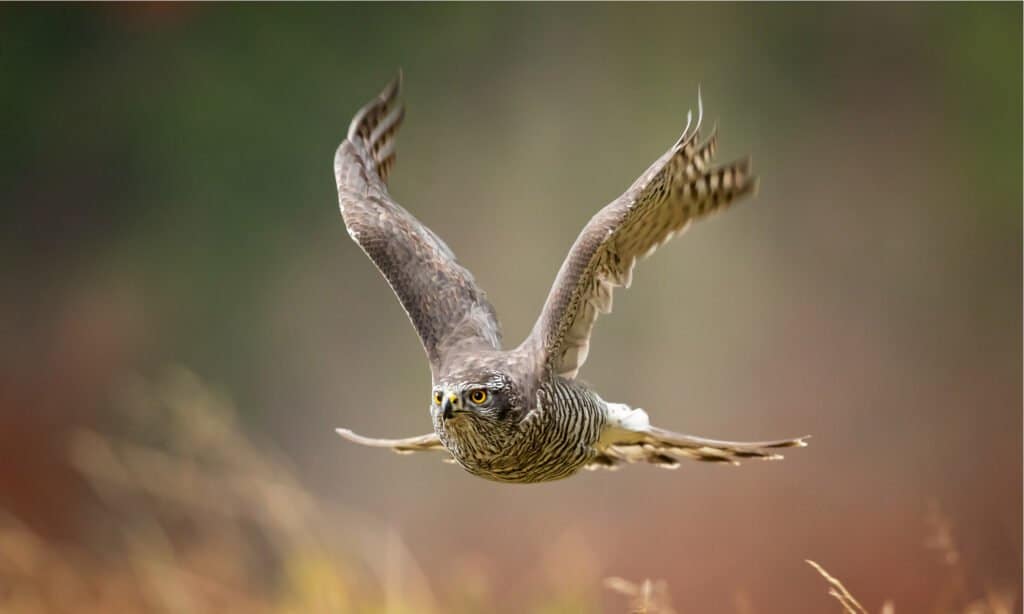
Goshawks are known to prey on European honey buzzards which resemble common buzzards
©Milan Zygmunt/Shutterstock.com
Goshawks have been known to kill and eat European honey buzzards. This behavior probably occurs because the European honey buzzards resemble the common buzzard, which Goshawks occasionally feed on. Information on the predators that consume the other types of honey buzzards isn’t readily available.
Reproduction, Babies, and Lifespan
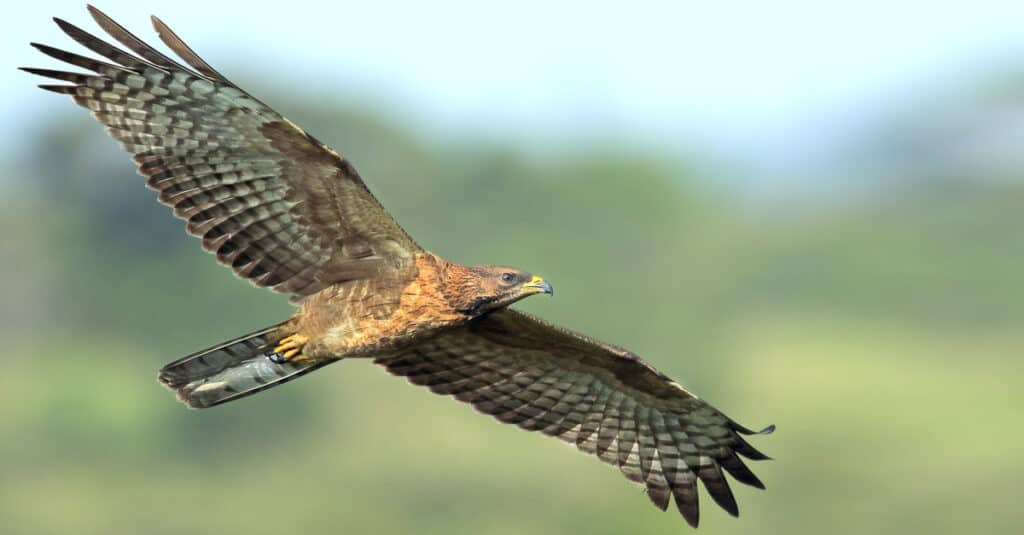
European Honey Buzzards take great care to camouflage their nests which are built using twigs and leaves
©Wang LiQiang/Shutterstock.com
The breeding habits and lifespan of the six types of honey buzzards differ. The habits of the European honey buzzard follow.
European honey buzzards have large territories ranging from 6 to 25 miles that often overlap with neighboring pairs’ home ranges. The size of the territory is determined by the availability of wasp and bee larvae and other prey. Mated pairs defend the area surrounding their nest against other birds of prey.
Nests
European honey buzzards generally build new nests 33 – 66 feet above the ground, but sometimes they modify old crow and common buzzard nests. They construct their nests from twigs and camouflage the upper portion with green leaves. They add fresh leaves throughout the nesting period to ensure that their nests are well camouflaged. The female executes the majority of the nest construction, which takes 10 – 15 days.
Beginning in May, European honey buzzards lay clutches of two white eggs that are almost completely covered with dark purplish splotches over 3 to 5-day intervals. Incubation takes 30 – 35 days per egg. Both parents sit on the eggs, but the female does the bulk of the incubation, including the night shifts. If the female dies, the male will brood and raise the chicks on his own.
Lifespan
The average age of honey buzzards in the wild is unknown. The oldest known wild European honey buzzard was almost 12 years old.
Population
With the exception of one type, honey buzzards appear to be in excellent health. Five are considered to be species of least concern by the IUCN Red List.
- Long-Tailed Honey Buzzard
Red List Category: Least concern
Population size: Unknown
Population trend: Decreasing
- Barred Honey Buzzard
Red List Category: Least Concern
Population size: Unknown
Population trend: Decreasing
- Philippine Honey Buzzard
Red List Category: Least Concern
Population size: Unknown
Population trend: Decreasing
Red List Category: Least Concern
Population size: 290000 – 430000
Population trend: Stable
Red List Category: Least Concern
Population size: Unknown
Population trend: Decreasing
Only the Black Honey Buzzard of Papua New Guinea is listed as vulnerable on the IUCN Red List. See a list of all conservation statuses here.
Red List Category: Vulnerable
Population size: 6000-15000
Population trend: Decreasing
Honey Buzzards in the Zoo
Honey buzzards aren’t kept in American zoos, but European and Oriental honey buzzards can be found in zoos throughout Europe and in Israel, Russia, Singapore, and Turkey.
View all 104 animals that start with HHoney Buzzard FAQs (Frequently Asked Questions)
Are honey buzzards herbivores, carnivores, or omnivores?
Honey buzzards are omnivores.
What kingdom do honey buzzards belong to?
Honey buzzards belong to the kingdom Animalia.
What class do honey buzzards belong to?
Honey buzzards belong to the class Aves.
What phylum to honey buzzards belong to?
Honey buzzards belong to the phylum Chordata.
What family do honey buzzards belong to?
Honey buzzards belong to the family Accipitridae.
What order do honey buzzards belong to?
Honey buzzards belong to the order Accipitriformes.
What type of covering do honey buzzards have?
Honey buzzards are covered in feathers. Their feet and legs are covered in tough scales that protect them from being stung by wasps and bees.
In what type of habitat do honey buzzards live?
Honey buzzards live in dense forests and jungles.
What is the main prey for honey buzzards?
Honey buzzards prey upon insect larvae, frogs, young birds, and small mammals. They also consume some fruit.
What are some predators of honey buzzards?
Predators of honey buzzards include other large birds of prey and humans.
What are some distinguishing features of honey buzzards?
Honey buzzards have many adaptations that protect them from wasp and bee stings, including:
- Armor-like scales on their legs and feet
- Dense, overlapping feathers on their lores (the area around their nostrils)
- An elongated tip at the end of their long, curved bill that holds insects securely
- Narrow nostrils that prevent their noses from becoming clogged with wax and debris from their prey’s nests
How many eggs do honey buzzards lay?
Honey buzzards typically lay two eggs.
What is an interesting fact about honey buzzards?
Honey buzzards eat wasp and bee larvae, not honey!
What is the lifespan of a honey buzzard?
The average age of honey buzzards in the wild is unknown. The oldest known wild European honey buzzard was almost 12 years old.
What is the honey buzzard’s wingspan?
The wingspan of honey buzzards varies from species to species. The European honey buzzard has a wingspan of 4.2 to 4.9 feet.
How fast is a honey buzzard?
The top speed for a European honey buzzard is 50 miles per hour.
Could a honey buzzard kill you?
Honey buzzards are extremely elusive and probably wouldn’t attack a person except in self-defense. If they did, their sharp talons and beak could cause serious injuries.
Why are honey buzzards so special?
Unlike most raptors, honey buzzards primarily eat the larvae of wasps and bees. They have unique physical adaptations that allow them to hunt their prey without being stung. Also, they are sexually dimorphic, which is extremely unusual among birds of prey.
Where do honey buzzards live?
Honey buzzards live in dense forests and jungles where they fly stealthily from tree to tree.
How do honey buzzards have babies?
Honey buzzards lay eggs.
Thank you for reading! Have some feedback for us? Contact the AZ Animals editorial team.
Sources
- Bird Guides, Available here: https://www.birdguides.com/articles/identification/common-and-european-honey-buzzards-photo-id-guide/
- Wildlife Journal Junior, Available here: https://nhpbs.org/wild/Accipitridae.asp
- Data Zone, Available here: http://datazone.birdlife.org/species/factsheet/22694976
- eBird, Available here: https://ebird.org/species/lthbuz1
- The Peregrine Fund, Available here: http://www.globalraptors.org/grin/SpeciesResults.asp?specID=8282
- iNaturalist, Available here: https://www.inaturalist.org/guide_taxa/68187
- Birds of the World, Available here: https://birdsoftheworld.org/bow/species/barhob1/cur/introduction
- Birdlife International, Available here: http://datazone.birdlife.org/species/factsheet/sulawesi-honey-buzzard-pernis-celebensis
- Avibase, Available here: https://avibase.bsc-eoc.org/species.jsp?avibaseid=2588C5AF00728568
- Birdlife International, Available here: http://datazone.birdlife.org/species/factsheet/22735356
- Planet of Birds, Available here: https://www.planetofbirds.com/accipitriformes-accipitridae-philippine-honey-buzzard-pernis-steerei
- Birdlife International, Available here: http://datazone.birdlife.org/species/factsheet/black-honey-buzzard-henicopernis-infuscatus
- Planet of Birds, Available here: https://www.planetofbirds.com/accipitriformes-accipitridae-philippine-honey-buzzard-pernis-steerei
- Birdlife International, Available here: http://datazone.birdlife.org/species/factsheet/black-honey-buzzard-henicopernis-infuscatus
- Hawk and Owl Trust, Available here: https://hawkandowltrust.org/about-birds-of-prey/honey-buzzard
- Clive Finlayson (1970) Avian survivors: The History and Biogeography of Palearctic Birds
- Beauty of Birds, Available here: https://www.beautyofbirds.com/honeybuzzards.html
- Birdlife International, Available here: http://datazone.birdlife.org/species/factsheet/european-honey-buzzard-pernis-apivorus
- Bio One Complete, Available here: https://bioone.org/journals/journal-of-raptor-research/volume-40/issue-3/0892-1016_2006_40_244_SMOEHP_2.0.CO_2/SPRING-MIGRATION-OF-EUROPEAN-HONEY-BUZZARDS-PERNIS-APIVORUS-ALONG-THE/10.3356/0892-1016(2006)40[244:SMOEHP]2.0.CO;2.full
- Birdlife International, Available here: https://flightforsurvival.org/evolution-european-honey-buzzard/
- Thai National Parks, Available here: https://www.thainationalparks.com/species/crested-honey-buzzard
- Wildlife Journal Junior, Available here: https://nhpbs.org/wild/Accipitridae.asp
- BOU, Available here: https://bou.org.uk/british-list/bird-names/
- RSPB, Available here: https://www.rspb.org.uk/birds-and-wildlife/wildlife-guides/bird-a-z/honey-buzzard/breeding/
- Hawk and Owl Trust, Available here: https://hawkandowltrust.org/about-birds-of-prey/honey-buzzard
- Zootierliste, Available here: https://www.zootierliste.de/en/?klasse=2&ordnung=211&familie=21108&art=2080217&action=suche
- Birdlife International, Available here: https://flightforsurvival.org/european-honey-buzzard/

